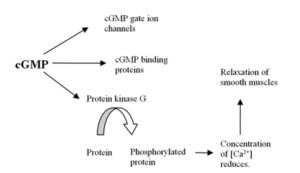Competitive inhibition prevents a biochemical reaction by inhibiting the responsible enzyme.
Several competitive inhibition examples and their mechanisms are documented in the field of biochemistry. This article will discuss some of these inhibitors in detail.
Examples of competitive inhibitors:
- Relenza
- Sildenafil
- Malonic acid
- Sulfanilamide
- Ranitidine
- Tranexamic acid (TXA)
- Alpha-glucosidase inhibitors
- Allopurinol
- Ampicillin
- Trilostane
- Salicylate
- Methotrexate
- Polyoxins and nikkomycins
Relenza
Relenza medication is used to cure influenza. The viral enzyme neuraminidase cleaves haemagglutinin that anchors the virion to the host body cell. The influenza inflammation is spread by the released virions. These virions infect the healthy cells of the body.
Relenza competes with haemagglutinin and binds to neuraminidase which in turn inhibits cleavage of haemagglutinin. The intact haemagglutinin tethers virion to the host body cell preventing the spread of influenza inflammation.
Sildenafil
Nitric oxide binds to the receptors in smooth muscle cells and increases cGMP (cyclin guanosine monophosphate). Increased level of cGMP leads to vasodilation through increased blood flow.

PDE5 enzyme plays an inhibitory effect on vasodilation by degrading cGMP. Sildenafil binds to the active site of PDE5 enzyme and inhibits its activity by competing with cGMP. It leads to inhibition of cGMP degradation.
Malonic acid
Malonic acid binds to the active site of succinate dehydrogenase and inhibits its activity by competing with succinic acid. It prevents the binding of succinic acid to the active site of succinate dehydrogenase and restricts the oxidization of succinic acid to fumaric acid.
Sulfanilamide
Sulfanilamide competes with para-aminobenzoicic acid (PABA) to bind to the active site of dihydropteroate synthetase. PABA is an intermediate substrate for folic acid synthesis. Sulfanilamide prevents folic acid synthesis in bacteria by blocking the binding site of PABA.
Ranitidine
Ranitidine is an FDA-approved, over-the-counter medication used to cure dyspepsia, indigestion, and heartburn. It inhibits H2 receptors in gastric parietal cells which in trun reduces gastric acid volume and concentration.
Tranexamic acid (TXA)
TXA is used to reduce heavy menstrual bleeding and also provides short-term prevention in hemophilic patients. It competes with lysin for its receptor on plasminogen.
The binding of TXA on the lysin receptor prevents activation of plasminogen (plasmin). This leads to binding and stabilization of the fibrin matrix and also blocks the breakdown of blood clots to prevent bleeding.
Alpha-glucosidase inhibitors
Alpha-glucosidase inhibitors arewell-known anti-diabetic medications and are known to inhibit the alpha-glucosidase enzyme in the intestinal villi which delays glucose absorption and digestion.
Allopurinol
Allopurinolinhibits uric acid formation by competing with hypoxanthine for the binding site of xanthine oxidase. Xanthine oxidase converts hypoxanthine to xanthine which is a substrate of purine metabolism.
Ampicillin
Ampicillin inhibits bacterial cell wall synthesis. It is semisynthetic penicillin that competitively inhibits transpeptidase. Transpeptidase is required for the synthesis of the bacterial cell wall.
Trilostane
Trilostane inhibits cortisol synthesis to prevent corticol secretion from adrenal cortex in dogs. It competitively inhibits 3-beta-hydroxysteroid dehydrogenase.
Salicylate
Salicylate inhibits 3-phosphoglycerate kinase and ethanol dehydrogenase, however, it does not have any structural resemblance with the substrate. It is a unique example of competitive inhibition.
Methotrexate
Methotrexate is an antineoplastic medication. It competes with folic acid to inhibit dihydrofolate reductase which prevents tetrahydrofolate formation from dihydrofolate. It prevents unregulated cell proliferation in cancer. It is known to block cell division by interrupting DNA synthesis in proliferating cells.
Polyoxins and nikkomycins
Polyoxins and nikkomycins play a key role in fungal prevention by inhibiting chitin synthesis. It competes with UDP-N-acetyl glucosamine which is a substrate for chitin synthesis.
What is competitive inhibition?
Competitive inhibition is a reversible reaction. An inhibitor having structural similarity with the substrate forms enzyme-inhibitor complex. This inhibitor binds to the active site of the enzyme non-covalently.
This complex prevents binding of the actual substrate at the active site, inhibits enzyme activity, and prevents product formation. With the increased concentration of the substrate, this reaction can be reverted. It is a well-known mechanism followed by a wide range of antibiotics to prevent the growth of bacterial pathogens.
What is non-competitive inhibition?
Non-competitive inhibition is a reversible reaction. A non-competitive inhibitor inhibits the enzyme by binding to the allosteric site. Due to dissimilarity in their structure, it does not compete with the substrate for the active site of the enzyme.
An enzyme-substrate-inhibitor complex is formed when both the inhibitor and the substrate bind the enzyme at the same time. The enzyme has an equal affinity for both the inhibitor and the substrate. The inhibitor changes the conformation of the active site of the enzyme thereby preventing product formation.
Give two examples of non-competitive inhibitors.
Cyanide is a prominent example of a non-competitive inhibitor. It causes acute cyanide toxicity by inhibiting ATP production. It changes the active site of cytochrome oxidase by binding to the allosteric site which prevents the transfer of electrons to oxygen in the electron transport chain.
Foscarnet or trisodium phosphonoformate inhibits the binding of pyrophosphate on DNA polymerase of herpes or hepatitis B pathogen.
Conclusion
We can conclude that competitive inhibitors play a significant role in curing a wide variety of disorders, such as bacterial or fungal inflammation.
Also Read:
- Filamentous bacteria examples
- Do prokaryotes have exons
- Protein denaturation process
- Bees characteristics
- Chemiosmosis in chloroplasts
- Box jellyfish types characteristics
- Purple sulphur bacteria examples
- Elbow anatomy
- Light independent reaction example
- Contractile vacuole in euglena
Hi..I am Moumita Nath, I have completed my Master’s in Biotechnology. I always like to explore new areas in the field of Biotechnology.
Apart from this, I like to read, travel and listen to Music.